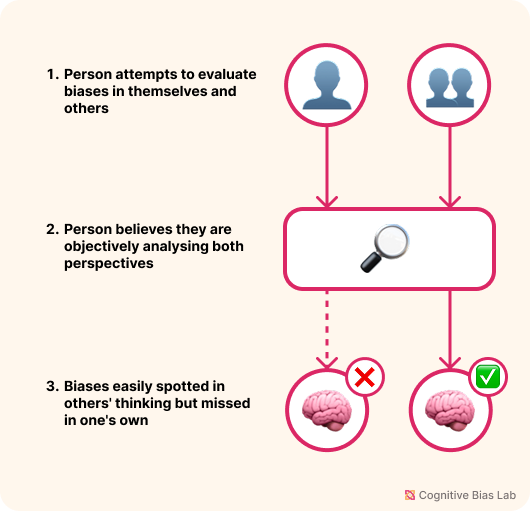Blind Spot Bias
Your progress on this bias test won't be saved after you close your browser.
Understanding Blind Spot Bias
Blind Spot Bias
We readily recognize cognitive biases in others while remaining oblivious to the same biases in ourselves. This meta-bias creates a dangerous illusion of objectivity that can undermine our decision-making quality.
What Is Blind Spot Bias?
Blind spot bias refers to the tendency to recognize cognitive biases in others while failing to see them in ourselves. Most people believe they are less susceptible to bias than their peers, even when presented with evidence to the contrary. This illusion of objectivity can lead to overconfidence in our judgments and a lack of corrective self-awareness.
How It Works
At its core, blind spot bias stems from the asymmetry between how we evaluate others' behavior versus our own. We observe others from the outside—seeing patterns, errors, or inconsistencies more clearly—while experiencing our own thinking as internally justified and rational. Because our reasoning feels “transparent” to us, we are less likely to question it or spot flaws.
This bias persists even among people trained in critical thinking or psychology, suggesting that simply knowing about bias doesn’t eliminate its influence. In fact, studies show that those who are most confident in their objectivity are often no better—and sometimes worse—at avoiding bias in their reasoning.
Relation to the Dunning-Kruger Effect
Blind spot bias is a specific expression of the Dunning-Kruger Effect, which describes how individuals with low skill or awareness often overestimate their competence. In the case of bias detection, we assume we are more rational and fair-minded than others, not realizing that this very belief can blind us to our own errors in thinking.
This creates a double disadvantage: not only are we likely to make biased decisions, but we’re also resistant to acknowledging them, making correction difficult.
Implications
The blind spot bias is especially dangerous in domains that require high levels of objectivity—such as leadership, hiring, law, and science—because it fosters unjustified confidence. It can lead to unfair evaluations, resistance to feedback, and systemic errors that go uncorrected because individuals don’t believe they’re part of the problem.
Addressing blind spot bias requires deliberate external feedback mechanisms and humility in evaluating our own cognitive performance.

Visual representation of Blind Spot Bias (click to enlarge)
Examples of Blind Spot Bias
Here are some real-world examples that demonstrate how this bias affects our thinking:
The Performance Review Paradox
A manager conducts performance reviews and easily identifies biases in how her colleagues evaluate employees. She notices one colleague consistently gives higher ratings to team members who share his alma mater (similarity bias), while another overweights recent performance (recency bias). However, when evaluating her own team, she remains completely unaware that she consistently attributes successful projects to team members she personally hired (self-serving bias) and undervalues contributions from employees who communicate differently than she does (in-group bias). Despite priding herself on fair evaluations, she's blind to her own biased judgments.
The Political Pundit Predicament
During election coverage, a politically engaged viewer accurately identifies numerous biases in commentators who support the opposing party. He notices their selective use of statistics, dismissal of contradictory evidence, and tendency to explain away scandals. However, when watching pundits aligned with his preferred party, he fails to notice they employ identical tactics. When his partner points this out, he defensively argues that "our side" is simply presenting facts while "their side" is clearly biased, demonstrating a profound blind spot regarding his own partisan filtering of information.
How to Overcome Blind Spot Bias
Here are strategies to help you recognize and overcome this bias:
Shift Perspectives
Ask how a critic might view your reasoning or what biases they’d see. This forces reflection from outside your usual frame.
Use Bias Review Partners
Share your decision process with someone who thinks differently. Their role is to spot biases you may have missed, not to judge outcomes.
Test Your Understanding
Challenge yourself with these questions to see how well you understand this cognitive bias:
After attending a workshop on cognitive biases, a CEO implements bias training for her executive team but exempts herself, believing she's already self-aware. What explains her reasoning?
Academic References
- Pronin, E., Lin, D. Y., & Ross, L. (2002). The bias blind spot: Perceptions of bias in self versus others. Personality and Social Psychology Bulletin, 28(3), 369-381
- Seda, L., Martins, I. T. C., De Carvalho Lisbôa, T. L. R., Batistuzzo, M. C., & Fatori, D. (2024). Theoretical maturation of the “Bias blind spot”: a preregistered replication study of Pronin, Lin, and Ross (2002) in a Brazilian sample. Collabra Psychology, 10(1).
- Washington, L., Beer, A., & Kulik, C. T. (2024). Gender, place leadership and levelling up across regions. Contemporary Social Science, 1–19.